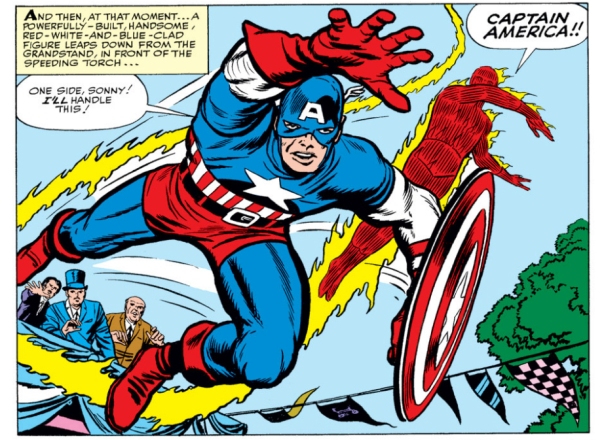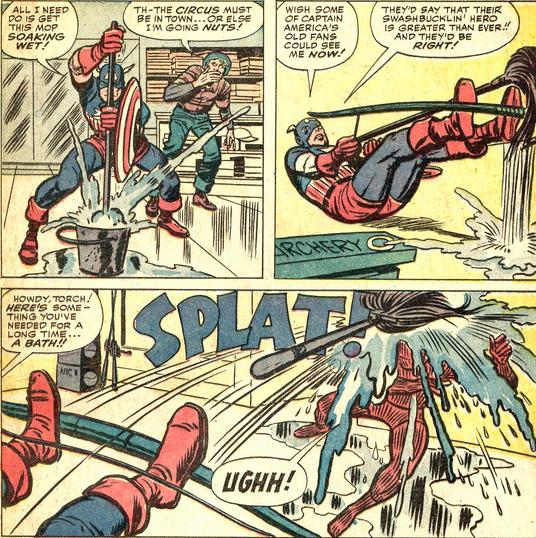This is extraordinarily cool. I look forward to Captain America. Give Graphic Policy a follow. Related articles Winter Soldier Diamond Select Toys Pics Revealed (comicvine.com) Captain America: The Winter Soldier Gets A First Look (shockya.com) Chevrolet is the Star of the new movie ‘Captain America’ (evanshalshaw.com) New ‘Captain America: The Winter Soldier’ Magazine Covers (screenrant.com) […]
Category Archives: Captain America
How the Appearance of Captain America Marked the Downfall of the Human Torch
By: Julian Munds
 I was so exited when I picked up this issue.
I was so exited when I picked up this issue.
My excitement always boils over when I see a new character.
Some of the characters that I have been reviewing ad nauseam, like the Human Torch, have begun to get really dry. When I saw Steve Rogers, engaged in mortal combat with the Torch, on the cover, I grew giddy with anticipation.
Finally, I get to start discussing what makes Captain America tick. Nevermind the fact that I already new that his true Silver Age debut came in a later issue of the Avengers. I still allowed my excitement to drive me.
Sadly, after reading this issue I am depressed.
The seeming appearance of Captain America turned out to be the Acrobat in disguise.
Apparently, the Acrobat thinks that framing a Golden Age character that hasn’t been seen in decades was a smart idea. More on that later.
This issue signals a change in Marveldom’s focus on the Human Torch. The mistaken appearance of Captain America, even though it isn’t him, marked the beginning of the downfall of the Human Torch as the flagship character.
The Fantastic Four, in the early years of the Silver Age, were the metronome of Marveldom. What went on within their pages directly influenced how the other characters would be written. However, as 1962 and 63 progressed, the other characters began to outshine the rather vanilla personalities of the Four.
Iron Man and Hank Pym were cracking away at the genius of Mr. Fantastic. Hank McCoy was doing Thing’s schtick far better then Thing. Jean Grey and Janet Van Dyne were showing that the Invisible Woman is not the only female capable of holding her own with the male characters.
Not to mention, Spider-Man’s slow regicide of the Torch was beginning to destroy the teen appeal of his title.
The Human Torch’s position as the flagship character of Marvel was waining.
Within the Fantastic Four itself, Torch was still wildly popular and some of his best stories will still being written. It was his solo adventures, here in Strange Tales, that were seriously under threat.
Strange Tales had never been a huge seller for Marvel. Since the solo escapades of Torch had been made the focal point of the publication, no improvements in sales had been recorded.
This was until two events: one, the Strange Tales annual which featured a cameo crossover from Spider-Man and two, the debut of the whacky and psychedelic Dr. Strange in the Summer of 1963. Both of these issues sold better then any single issue that just featured only Johnny.
Taking note of the rather eclectic response to the Solo Torch adventures, Stan Lee decided to use the publication as a place to experiment with more inventive characters and treatments of the other mainstays. For instance, Ben Grimm’s cameos in the publication were often grittier and angrier then his appearances in Fantastic Four. Sue Storm’s cameos were more fleshed out, and she was often far more composed then her Fantastic Four incarnation.
Because Strange Tales had a small fan base and a very loyal one, as many that bought these comics had been on board since 1961 refocus, they were extraordinarily vocal and very hard to alienate. Naturally, Stan Lee saw the value in this. He could use the publication as a place to test things out for the future. And so the Captain America experiment happened.
I do not profess to be an expert on the Golden Age of Marvel. I know a few tidbits of facts and have read one or two issues from that period. Frankly, it is a era I am more familiar with through the lens of DC. That being said, I do understand the importance of Captain America.
He is a character that began as American propaganda personified. Much like Superman of the war period, Captain America came out of a xenophobic, propagandist “America crushes her enemies at all costs” mindset.
He had very little edge to him and was a golden boy personification of war bonds advertisements.
His character makes even littler sense in the anti-establishment world of the early 60s.
Keep in mind that this issue debuted only three weeks before the assassination of JFK which spurred on the counter culture revolution.
Stan Lee had begun to reap great success from the reestablishment of Marvel as a place for superheroes. He did this by creating each character as a direct parody to the prior archetypes that flooded DC.
Stan also had enormous success with updating two of the greatest characters of the Golden Age; the Human Torch and Sub-Mariner; though the latter was now a villain.
His new realist take on characters might could apply to Steve. However, this was a gamble, as the Cap represented the parents of those who read the comics. Thus, he wanted to test the reaction people would have to the Captain’s return.
When Steve first appears, giving a speech to a group about his return, it really seems that he is actually the real man. Even when the Cap is clearly helping a group of robbers take down a bank and by extension fighting the Torch, it seems like Stan has brought back America as a villain like he did with Namor.
When the big reveal comes at the end; that the whole time it was Acrobat behind the shield, it really is a brilliant twist. When this story was read in November 1963, it must have bowled over the readers.
However, when I read this now, knowing the vast history of Captain America in modern Marvel, it doesn’t have much allure.
The plot is pretty run of the mill: a bank robbery. And Torch could very well be part of the scenery.
This issue really isn’t about Torch or Acrobat. It is a glorified focus group.
This story is an interesting in moment in Marvel history but not a very interesting story.
Story I Read: “The Human Torch… Meets Captain America” (Strange Tales #114 Nov. 1963)
Rating: 2 out of 5
Pros: Cool idea. Lovely buzzy cover image. Really exciting battle between the two.
Cons: Not much story. Feels gimmicky. Torch sees no development here.
Previous Review: “Face to Face with the Lizard!” (The Amazing Spider-Man #6 Nov. 1963)
Upcoming Review: “The Return of the Omnipotent Baron Mordo” (Strange Tales #114 Nov. 1963)
Related articles
- A History of the Silver Age (jou300202.wordpress.com)
- ‘Captain America,’ ‘Thor’ strike at Disney expo (bigstory.ap.org)
- My geek of the week… (loubylashes.wordpress.com)
- Sequential art that doesn’t necessarily need to be funny. (myimaginationcastle.wordpress.com)
- Captain America (ninjasinstitches.wordpress.com)
- COMICS: Peter Parker And The Human Torch Reunite In AMAZING SPIDER-MAN #700.5 Preview (comicbookmovie.com)
- Human Torch’s Marvel Team-Ups (gobacktothepast.com)
Captain America, The Odd War of Dimension Z: A Review
Captain America! To consumate expression of Marvel’s Americanism. He is a character from different time and has I have never really enjoyed his stories. But this arc, I found myself really quite lost in. Check out this fantastic review from eCharta’s Megan Cubed.
Related articles
- CAPTAIN AMERICA: THE WINTER SOLDIER Motion Poster Spotted (comicbookmovie.com)
- Captain America (bubblesofmischief.com)
- Captain America: Living Legend #1 Review (comichype.com)
Rebooting after Ed Brubaker’s acclaimed run on the title, the newly rebranded Marvel NOW Captain America from writer Rick Remender and artist John Romita, Jr. recently wrapped up its first arc, The Odd War of Dimension Z. In a story that spanned ten issues and twelve years, this bold new chapter in Captain America’s enduring saga saw the rise of a surprising new status quo. Steve Rogers finds himself abducted by Armin Zola and whisked away to the bizarre wasteland of Dimension Z, with only the principles he learned from his mother Sarah to keep him going. A stark departure from that Sentinel of Liberty we know, he’s stripped of his usual power and authority, haggard and battle-scarred after over a decade on the run, without the luxury of superhero friends and A-List guest stars to bail him out. Now a single father, he’s charged with caring for his…
View original post 1,615 more words







